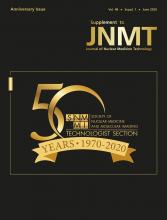The way we educate and process information, and what we teach has changed dramatically in 50 years. In 1970, the only way to get information was through an encyclopedia, going to a library and using the Dewey Decimal system to find reference books or buy them outright. The Dewey Decimal System was first published in 1876 by Melvil Dewey as a systematic way to reference all books in a library and is still used to this day. The code for Nuclear Medicine is 616.075. Journals were in a separate section in a library associated with newspapers and microfilm/microfiche. Microfilm and microfiche need a microform reader to assess/copy and are actually still used to this day for long-time storage of documents. Now we have internet information platforms such as Google, which allows for virtually all the information ever gathered as a human race to be at the fingertips of everyone with a smartphone and/or personal computer. Gone are the days of depending on a library for information and references; however, one should be cautious that not all information on the internet is legitimate. Trust but verify is still a necessary element in data gathering and in knowledge development in the educational process. In 1970, NMT was still in its infancy as an imaging modality and what was being taught was in some ways much different than now but also amazedly some areas we teach are the same—from rectilinear scanners, liquid scintillation cameras, and homemade 99Mo/99mTc generator systems, which have gone the way of the dinosaur, to the traditional Anger gamma camera, which essentially works the same to this day. In the many generations of camera systems we have had of the Anger gamma-type camera system since the 1970s, the biggest improvements have been with better energy resolution, better overall resolution, and improved count rate ability. This has allowed for reduced activity for many studies and led to the concept of “half dose and half the time” to acquire images. Exams that took an average of 30–40 minutes in the 1970s now can average 10–15 minutes or less. We now also have specialty cameras that are direct to digital, allowing for even greater energy resolution, overall resolution and better count rates. The limitation of these systems in that scaling to whole-body imaging is difficult and they have been small field of view systems ideal for cardiac imaging, which is our largest volume study in nuclear medicine overall. In teaching aspects of nuclear medicine, we have had to cover all elements of the many generations of cameras, image delivery, and now hybrid imaging such as PET/CT and PET/MRI. The advances have made it difficult to teach all of the basics and all of the advances. Through the years as new radiopharmaceuticals are approved, curricula and classes have had to be modified and improved. The SNMMI-TS has done a really good job through the years of keeping an Education Curriculum Guide up to date, which helps guide the educators, the JRCNMT, and the certification agencies as well.
In being involved in the education process in nuclear medicine for nearly 30 years, I can attest to the vast differences in educating nuclear medicine technology students has had through the years. When I first started, we were using overhead projectors and slides to teach. Presentations had to be coordinated by physically laying out slides and loading carousals. Handwritten or typed information had to be made on overhead projection clear sheets. We went from all handwritten sheets to typed sheets that could be photocopied—that was actually an advancement. VHS tapes were used as videos, which required television sets to be wheeled into the rooms. There was no integration of information in one area. Reference books had to be bought, and access to information was limited to what students could get by taking notes in class, photocopying instructor notes, or exploring what resources were available in the university library. Exams were all handwritten and typed up and photocopied and hand graded. This advanced to the scantron system of filling in bubbles and using a special scantron counter to grade exams. We evolved from this seemingly archaic system to now having a learning management system on the internet through a campus-acquired and -protected system, where all course materials are loaded into a course “shell.” Everything is in one place, the instructor can teach using PowerPoint or Prezi or another advanced technique, and videos and exams can be delivered through this system. All electric, and education can be done completely paperless. All course notes and presentations are available to students, and courses can even be delivered entirely through the internet remotely. Real-time simulcasts can be done, and exams can be monitored via systems such as ProctorU or remote video monitoring. At each stage of change in the way we deliver content to the student, materials had to be converted. Handwritten notes and writing on chalk boards moved to overhead projection sheets and slides, which led to PowerPoint conversion to migrating to learning management systems. Most students today consider themselves visual learners and heavily rely on internet videos, such as those from YouTube, to learn most information. There is still a need for books and guidance in the education process, as it appears most students like referring to reference books to back up what they have learned and to study for board exams, but long gone are the days that information is not readily available to anyone who has a computer. I cannot imagine what the next 50 years may bring in changes to the way we educate and what advances in Nuclear Medicine Technology that we will have for teaching, training, and educating our students, but I look forward to the continued evolution.










